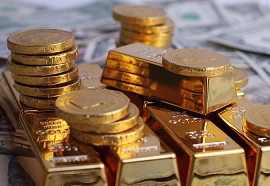Investor Ideas: In Gold We Trust

Article by Richard Mills in Investor Ideas
Inflation is one of the best determinants of gold price movements, because investors buy precious metals (gold, silver, platinum and palladium) as an inflation hedge when the prices of goods and services are rising faster than interest rates.
Although gold offers neither a yield (bonds, GICs) nor a dividend (stocks and mutual funds), it is considered a smart investment when inflation diminishes an investor's principal or erodes the purchasing power of a currency.
Negative real rates
Gold is even more popular when real interest rates, typically the yield on the US 10-year Treasury note minus the inflation rate, are below zero, like currently.
The reason for this is simple, when real interest rates are at or below 0%, cash and bonds fall out of favor because the real return is lower than inflation. If you are earning 1.6% on your money from a government bond, but inflation is running 2.7%, the real rate you are earning is negative 1.1% - an investor is actually losing purchasing power. Gold is the most proven investment to offer a return greater than inflation, by its rising price, or at least not a loss of purchasing power.
Stagflation warning
In our last article we had three prominent economists claiming that stagflation, defined as high inflation amid a recessionary or low-growth environment, is likely to dog the global economy for the medium to long term.
Nouriel Roubini identified nine supply shocks that are likely to keep the prices of goods and services elevated.
Harvard economics professor Ken Rogoff, writing for Project Syndicate, suggests the parallels between the 2020s and the 1970s just keep growing. Has a sustained period of high inflation just become much more likely? Until recently, I would have said the odds were clearly against it. Now, I am not so sure, especially looking ahead a few years.
Rogoff points to two key similarities between the economic situation 50 years ago and the one currently: a supply shock (the 1973 oil embargo versus the current pandemic-related disruptions to supply chains), and a government spending spree (President Lyndon Johnson splashed out big-time during his "Great Society" programs followed by generous Vietnam War spending; the Trump and Biden administrations have, combined, doled out $5.8 trillion in pandemic relief, with trillions more in social/ climate spending, still to come from the Biden White House.)
Former Yale economics prof Stephen Roach summons the ghost of Arthur Burns, the Fed chair during the Nixon administration, in explaining how inflation is actually worse than reported.
US inflation
Zeroing in on the United States, data next week is forecast to show consumer prices rising by more than 5% for a third straight month in August (July CPI was 5.4%).
Prices paid by producers increased in August by more than forecast due to persistent supply chain interruptions, as well as more expensive labor, Bloomberg reported on Friday, with the producer price index pushing 0.7% higher compared to July and +8.3% from a year ago.
We are getting a clearer picture of how much supply shortages are feeding into US inflation, and that inflation is "supply-side" not "demand-side".
Via CNBC, the Beige Book reports businesses are experiencing escalating inflation that is being aggravated by a shortage of goods and likely will be passed onto consumers in many areas.
Surveys indicate that Americans are increasingly worried about escalating inflation. Along with rising food and gas prices, one of the most noticeable manifestations of inflation for the average Joe and Jane is the increase in rent.
The surge in housing prices that began 18 months is another factor likely to keep increasing rents.
Conclusion
Global debt more than doubled from $116 trillion in 2007 to $244 trillion in 2019. It now sits at $281 trillion.
The United States is the undisputed champion of unsustainable IOUs; the country is approaching a national debt of $29 trillion. In fact, the debt is likely to hit at least $34 trillion by the end of this year, with all the spending promises laid out by the Biden administration, either passed by Congress or in progress.
There is a clear link between a rising debt to GDP ratio and gold prices.
In October 2020 the US ratio surpassed 100% for the first time since the Second World War; it now sits at 125%.
The pandemic is testing belief in the dollar and other major currencies like never before.
Excessive money-printing not only in the United States, but Britain and the EU, is continuing to devalue currencies at an alarming rate (this, by definition, is inflation, because it takes more units of currency to buy the same amount of goods as before) - for which precious metals, namely gold and silver, are the best defense.
Inflation erodes the purchasing power of fiat currencies and eventually they become worthless. The dollar has lost 90% of its purchasing power since 1950.
By contrast, since 1972 gold has gone from $35/oz to $1,800.
Owning gold (and silver) continues to be the best defense against inflation, stagflation, and rampant currency debasement, during ......
To read this article in Investor Ideas in full and view all relating charts, click here.